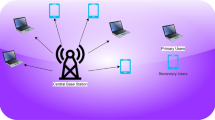Abstract
One fundamental issue in cognitive radio mobile ad hoc networks (CR-MANETs) is the selection of a stable path between any source and destination node to reduce the end-to-end delay and energy consumption arisen from route reconstruction. In this way, we analyse the link stability by calculating the link life time that is dependent on failures caused by secondary users’ (SUs) movements and primary users’ (PUs) activities. We propose a joint stability-based routing, link scheduling and channel assignment (SRLC) algorithm in CR-MANETs, which is benefited from considering the link life time, amount of interference imposed on PUs and energy consumption. The proposed algorithm selects a frequency channel/time slot in a way that channel utilization and previous behaviours of SUs and PUs, are taken into account. In the proposed SRLC, the concept of load balancing is applied by avoiding to route packets through SUs with insufficient energy. The effectiveness of the proposed algorithm is verified by evaluating the aggregate interference energy, end-to-end delay, goodput and the energy usage per packet transmission under three different scenarios. The results show our proposed scheme finds better routes compared to the recently proposed joint stable routing and channel assignment protocol.






Similar content being viewed by others
References
Mitola, J., & Maguire, G. Q. (1999). Cognitive radio: Making software radios more personal. IEEE Personal Communications, 6(4), 13–18.
Abbagnale, A., & Cuomo, F. (2010). Gymkhana: A connectivity-based routing scheme for cognitive radio ad hoc networks. In IEEE INFOCOM conference on computer communications.
Guan, Q., Yu, F. R., Jiang, S., & Wei, G. (2010). Prediction-based topology control and routing in cognitive radio mobile ad hoc networks. IEEE Transactions on Vehicular Technology, 59(9), 4443–4452.
Carofiglio, G., Chiasserini, C. F., Garetto, M., & Leonardi, E. (2009). Route stability in MANETs under the random direction mobility model. IEEE Transactions on Mobile Computing, 8(9), 1167–1179.
Tang, F., Guo, M., Guo, S., & Xu, C. Z. (2016). Mobility prediction based joint stable routing and channel assignment for mobile ad hoc cognitive networks. IEEE Transactions on Parallel and Distributed Systems, 27(3), 789–802.
Maleki, E. N., & Mirjalily, G. (2016). Fault-tolerant interference-aware topology control in multi-radio multi-channel wireless mesh networks. Computer Networks, 110, 206–222.
Turgut, D., Das, S. K., & Chatterjee, M. (2001). Longevity of routes in mobile ad hoc networks. In IEEE conference on vehicular technology.
Gruber, I., & Li, H. (2002). Link expiration times in mobile ad hoc networks. In IEEE conference on local computer networks.
Samar, P., & Wicker, S. B. (2006). Link dynamics and protocol design in a multihop mobile environment. IEEE Transactions on Mobile Computing, 5(9), 1156–1172.
Wu, Y. T., Liao, W., Tsao, C. L., & Lin, T. N. (2009). Impact of node mobility on link duration in multihop mobile networks. IEEE Transactions on Vehicular Technology, 58(5), 2435–2442.
An, B. (2013). The analysis of route availability and route stability in mobile ad-hoc wireless networks. In IEEE conference on ubiquitous intelligence and computing.
Rashid, U., Waqar, O., & Kiani, A. K. (2017). Mobility and energy aware routing algorithm for mobile ad-hoc networks. In IEEE conference on electrical engineering (ICEE).
Shafigh, A. S., Veiga, B. L., & Glisic, S. (2018). Cross layer scheme for quality of service aware multicast routing in mobile ad hoc networks. Wireless Networks, 24(1), 329–343.
Filippini, I., Ekici, E., & Cesana, M. (2013). A new outlook on routing in cognitive radio networks: Minimum-maintenance-cost routing. IEEE/ACM Transactions on Networking (TON), 21(5), 1484–1498.
Dutta, N., & Sarma, H. K. D. (2017). A probability based stable routing for cognitive radio adhoc networks. Wireless Networks, 23(1), 65–78.
Zhou, T., Tang, F., Li, J., Yang, Y., Xu, W., Yao, B., & Guo, M. (2015). Joint routing and channel assignment for delay minimization in multi-channel multi-flow mobile cognitive ad hoc networks. In IEEE conference on global communications.
Zhou, J., Tang, F., Li, J., Xu, W., & Guo M. (2015). Joint channel assignment, stable routing and adaptive power control in mobile cognitive networks. In IEEE conference on wireless communications and networking (WCNC).
Xue, Y., Tang, C., Tang, F., Yang, Y., Li, J., Guo, M., & Wu, J. (2016). Primary user activity prediction based joint topology control and stable routing in mobile cognitive networks. In IEEE conference on wireless communications and networking (WCNC).
Tang, F., Tang, C., Yang, Y., Yang, L. T., Zhou, T., Li, J., et al. (2017). Delay-minimized routing in mobile cognitive networks for time-critical automation applications. IEEE Transactions on Industrial Informatics, 13(3), 1398–1409.
Zhang, H., Qiu, Y., Long, K., Karagiannidis, G. K., Wang, X., & Nallanathan, A. (2018). Resource allocation in noma based fog radio access networks. arXiv preprint arXiv:1803.05641.
Zhang, H., Liu, N., Long, K., Cheng, J., Leung, V. C., & Hanzo, L. (2018). Energy efficient subchannel and power allocation for software-defined heterogeneous VLC and RF networks. IEEE Journal on Selected Areas in Communications, 36(3), 658–670.
Hawa, M., AlAmmouri, A., Alhiary, A., & Alhamad, N. (2017). Distributed opportunistic spectrum sharing in cognitive radio networks. International Journal of Communication Systems, 30(7), 1–30.
Xu, L., Nallanathan, A., Pan, X., Yang, J., & Liao, W. (2018). Security-aware resource allocation with delay constraint for NOMA-based cognitive radio network. IEEE Transactions on Information Forensics and Security, 13(2), 366–376.
Yang, T., Feng, H., Yang, C., Deng, R., Guo, G., & Li, T. (2018). Resource allocation in cooperative cognitive radio networks towards secure communications for maritime big data systems. Peer-to-Peer Networking and Applications, 11(2), 265–276.
Johnson, D. B., & Maltz, D. A. (1996). Dynamic source routing in ad hoc wireless networks. Mobile Computing, 353(1), 153–181.
Author information
Authors and Affiliations
Corresponding author
Rights and permissions
About this article
Cite this article
Amiri-Doomari, S., Mirjalily, G. & Abouei, J. Stability-based routing, link scheduling and channel assignment in cognitive radio mobile ad-hoc networks. Wireless Netw 25, 2013–2026 (2019). https://doi.org/10.1007/s11276-018-1793-1
Published:
Issue Date:
DOI: https://doi.org/10.1007/s11276-018-1793-1




